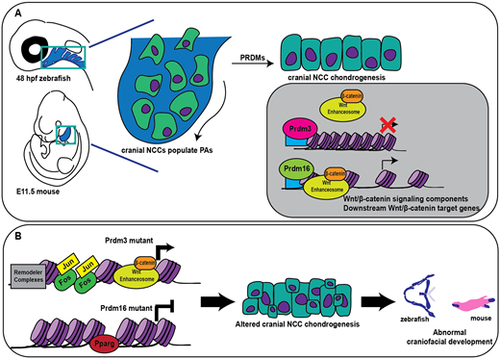Fig. 7
- ID
- ZDB-FIG-230309-8
- Publication
- Shull et al., 2022 - PRDM paralogs antagonistically balance Wnt/β-catenin activity during craniofacial chondrocyte differentiation
- Other Figures
- All Figure Page
- Back to All Figure Page
|
Prdm3 and Prdm16 function upstream of Wnt/β-catenin to balance transcriptional activity during craniofacial chondrogenesis. (A) In vertebrates, Prdm3 and Prdm16 facilitate cranial NCC chondrocyte differentiation and maturation by balancing temporal and spatial Wnt/β-catenin transcriptional activity; Prdm3 acts a repressor of gene expression and Prdm16 acts as an activator of similar gene targets, particularly Wnt/β-catenin signaling components and downstream Wnt/β-catenin target genes. (B) Loss of Prdm3 leads to enhanced gene expression and increased occupancy of chromatin remodelers and Jun/Fos whereas loss of Prdm16 causes a dramatic decrease in gene expression and increased occupancy of Pparg, among others. In both cases, Wnt/β-catenin signaling is abrogated leading to altered cranial neural crest chondrocyte differentiation and maturation, which ultimately leads to abnormal development of craniofacial structures. PAs, pharyngeal arches. |

